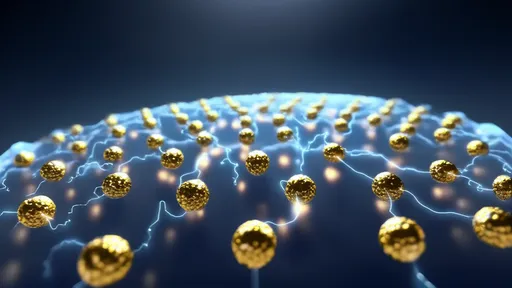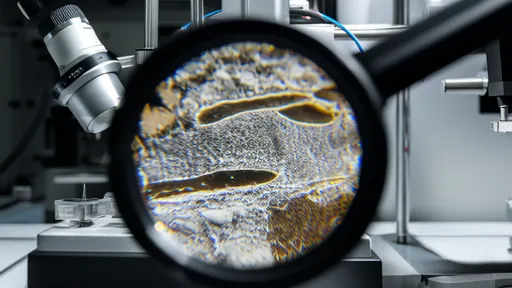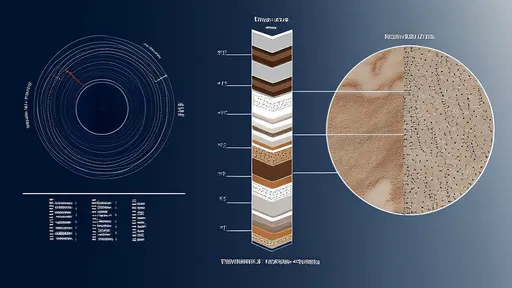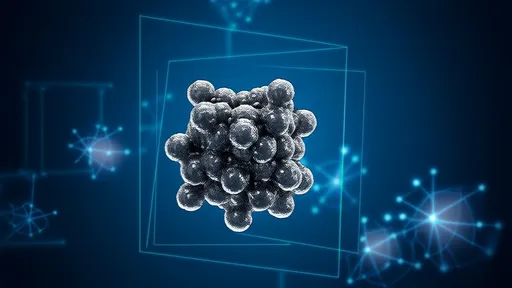The interaction between light and metal nanoparticles has fascinated scientists for centuries, but it's only in recent decades that we've begun to truly understand the quantum dance occurring at their surfaces. When light strikes these tiny metallic structures, something extraordinary happens - the free electrons collectively oscillate in resonance with the incoming electromagnetic waves. This phenomenon, known as surface plasmon resonance (SPR), represents one of the most intriguing intersections between photonics and nanotechnology.
At the heart of this behavior lies the unique electronic structure of metals. Unlike insulators or semiconductors, metals contain a "sea" of delocalized electrons that can move freely throughout the material. When confined to nanoscale dimensions, these electrons exhibit peculiar behaviors that don't occur in bulk materials. The surface plasmon resonance emerges when the frequency of incoming light matches the natural oscillation frequency of these collective electrons, creating a dramatic enhancement of the local electromagnetic field.
The physics behind SPR involves a delicate balance between the restoring forces acting on displaced electrons and their inherent inertia. As light waves hit the nanoparticle surface, they push the electron cloud away from the positively charged metal lattice, creating a charge separation. The resulting Coulomb attraction pulls the electrons back, but their momentum carries them past the equilibrium position, setting up an oscillating dipole. This coordinated electron motion generates secondary electromagnetic fields that can interact strongly with nearby molecules or other nanoparticles.
What makes plasmonic nanoparticles particularly fascinating is their ability to concentrate light below the diffraction limit. While conventional optics hit fundamental barriers in focusing light, plasmonic structures can squeeze electromagnetic energy into volumes smaller than the wavelength of light. This property has opened new possibilities in fields ranging from biomedical sensing to photovoltaics, where controlling light-matter interactions at the nanoscale is crucial.
The resonance frequency isn't fixed - it depends sensitively on factors like nanoparticle size, shape, composition, and the surrounding dielectric environment. Gold and silver nanoparticles typically exhibit strong plasmon resonances in the visible spectrum, which explains their vibrant colors that have been exploited in stained glass and artwork since ancient times. By carefully engineering these parameters, researchers can tune the plasmon resonance across ultraviolet, visible, and near-infrared regions to suit specific applications.
Recent advances in nanofabrication have allowed scientists to create nanoparticles with increasingly sophisticated architectures - from simple spheres to rods, stars, cages, and other complex shapes. Each geometry produces distinct plasmonic properties. For instance, nanorods exhibit two resonance peaks corresponding to electron oscillations along their short and long axes. This anisotropy enables multimodal sensing applications where different wavelengths can probe different aspects of the local environment.
The marriage of plasmonics with modern spectroscopy techniques has yielded powerful tools for chemical and biological detection. When target molecules bind to functionalized nanoparticle surfaces, they alter the local refractive index, causing measurable shifts in the resonance wavelength. This principle underlies some of the most sensitive label-free biosensors available today, capable of detecting single molecules in some configurations. The extreme field enhancement at "hot spots" between closely spaced nanoparticles further boosts sensitivity through mechanisms like surface-enhanced Raman scattering.
Beyond sensing, plasmonic nanoparticles are making impacts in therapeutics and imaging. Their ability to convert light into heat with remarkable efficiency enables photothermal therapies where carefully targeted nanoparticles can destroy cancer cells while sparing healthy tissue. Meanwhile, the strong scattering signatures of plasmonic nanoparticles make them excellent contrast agents for dark-field microscopy and other imaging modalities that benefit from bright, photostable labels.
In energy applications, plasmonic nanostructures help harvest sunlight more efficiently in photovoltaic devices. By carefully designing metal nanoparticle arrays on solar cell surfaces, engineers can trap light that would otherwise be reflected away, increasing absorption in the active semiconductor layers. Some designs even enable "hot electron" collection, where plasmon decay directly generates charge carriers that contribute to the photocurrent.
The quantum aspects of plasmon resonance have become an exciting frontier in fundamental physics. As researchers push toward smaller nanoparticles and examine plasmon dynamics with ultrafast spectroscopy, classical electromagnetic theory begins to break down, revealing quantum mechanical effects like electron tunneling and nonlocal screening. Understanding these phenomena could lead to novel quantum plasmonic devices that manipulate light-matter interactions at their most fundamental levels.
Challenges remain in translating laboratory discoveries into robust commercial applications. Nanoparticle stability, reproducible large-scale fabrication, and precise control over surface chemistry all represent active areas of research. Nevertheless, the unique properties of surface plasmon resonance continue to inspire innovations across disciplines, from medicine to renewable energy to quantum computing.
Looking ahead, researchers envision hybrid systems that combine plasmonics with other nanoscale phenomena like excitonics in 2D materials or superconducting quantum interference. These integrated platforms could enable unprecedented control over light at the nanoscale, potentially revolutionizing technologies like optical computing, ultracompact photonic circuits, and quantum communication networks.
The story of surface plasmon resonance exemplifies how a fundamental physical phenomenon, once properly understood and harnessed, can spawn transformative technologies. As nanoscience advances, our ability to design and manipulate these collective electron oscillations will only grow more sophisticated, promising solutions to some of society's most pressing challenges in healthcare, energy, and information technology.

By /Jun 19, 2025

By /Jun 19, 2025

By /Jun 19, 2025

By /Jun 19, 2025

By /Jun 19, 2025

By /Jun 19, 2025

By /Jun 19, 2025

By /Jun 19, 2025

By /Jun 19, 2025

By /Jun 19, 2025

By /Jun 19, 2025

By /Jun 19, 2025

By /Jun 19, 2025

By /Jun 19, 2025

By /Jun 19, 2025

By /Jun 19, 2025

By /Jun 19, 2025